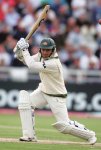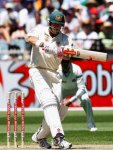venkyrenga
U19 12th Man
This is the updated version of the countdown I posted a while ago that ranked the top 30 test batsmen from the last 30 years. Before I move on to the top 30 bowlers, which will be a humongous task, I wanted to do some updates and fix some of the flaws in the methodology. The few updates I have done has changed the rankings considerably.
The important update is that I have adjusted the average of all the batsmen for average quality of bowling faced. Previously the system worked under the assumption that all batsmen in a given period has faced the same quality of bowling. But it is far from true, as certain teams face each other more often (ex. Aus&Eng, Pak&SL, etc.) and batsmen who play for teams with strong bowling attack have the benefit of not having to face their own attack. So after the adjustment, a batsman who faced quality bowling more often will have his average increased and vice versa. This is done by using no. of innings against each team and average runs conceded per wicket data for every 4-year period.
I will mention the other updates along with the basic methodology before starting the countdown. All comments are welcome but please keep in mind that no one methodology can satisfy everyone.
The measures used:
Batting average & RPI - I have used the formula, (0.75*avg*not outs)+Runs/Innings. The formula gives 3:1 weightage for batting average and RPI. This is done to reward batsmen who scored more runs with the same average.
Strike rate - I have taken 60 as the optimal SR with a 10% leeway. So it would be 54-66. (This range changes slightly for different periods. For example, in the 90s it is 50-64.) And for every 4 away from this range 1% of points will be deducted. So, if the SR is 50 or 70 the batsman will have 1% of his points deducted. For 46 or 74, it is 2% and so on. The idea is that a batsman with an SR in the optimal range is more capable of accelerating or decelerating depending on the situation unlike batsmen with a very high or low SR.
All average is adjusted for the era (every 4-year period).
Weightage for different categories:
Overall record 60%
Overseas record 20%
Peak record (Best 4 years) 10%
Record against best bowling attack 10%
The important update is that I have adjusted the average of all the batsmen for average quality of bowling faced. Previously the system worked under the assumption that all batsmen in a given period has faced the same quality of bowling. But it is far from true, as certain teams face each other more often (ex. Aus&Eng, Pak&SL, etc.) and batsmen who play for teams with strong bowling attack have the benefit of not having to face their own attack. So after the adjustment, a batsman who faced quality bowling more often will have his average increased and vice versa. This is done by using no. of innings against each team and average runs conceded per wicket data for every 4-year period.
I will mention the other updates along with the basic methodology before starting the countdown. All comments are welcome but please keep in mind that no one methodology can satisfy everyone.
The measures used:
Batting average & RPI - I have used the formula, (0.75*avg*not outs)+Runs/Innings. The formula gives 3:1 weightage for batting average and RPI. This is done to reward batsmen who scored more runs with the same average.
Strike rate - I have taken 60 as the optimal SR with a 10% leeway. So it would be 54-66. (This range changes slightly for different periods. For example, in the 90s it is 50-64.) And for every 4 away from this range 1% of points will be deducted. So, if the SR is 50 or 70 the batsman will have 1% of his points deducted. For 46 or 74, it is 2% and so on. The idea is that a batsman with an SR in the optimal range is more capable of accelerating or decelerating depending on the situation unlike batsmen with a very high or low SR.
All average is adjusted for the era (every 4-year period).
Weightage for different categories:
Overall record 60%
Overseas record 20%
Peak record (Best 4 years) 10%
Record against best bowling attack 10%
- I have considered the best 12-year period of a batsman's career for calculating the points as 12 years is about the mean career length of the top batsmen from the last 30 years. If a batsman had quality run outside the 12 years it will be included with a longevity bonus of 15% for twice the no. of years. For example, if I am considering 16 years for a batsman, he will get 5% additional points. And if a batsman has a career of less than 12 years, points will be deducted at the same rate. And 8 years is the minimum career length. For current players and batsman with shorter career, I have considered the best 8-year period with additional quality run. But years in the end has to be included for current batsmen as they are in the middle of their run.
- Points are calculated for every 4-year period and then averaged. But it has to be continuous 12 years, in other words three continuous 4-year periods. Points are also calculated for 1-year and 2-year periods in case it needed to be factored in after the 8 years or 12 years in consideration. And all records against minnows are excluded completely. Records against the standard eight teams are considered throughout and minnows are determined based on runs conceded per wicket data for each 4-year period.
- To determine the best bowling attack, I have used runs conceded per wicket data with more weightage for overseas record and taken top 2 opponents or sometimes 3 if runs conceded is very close (difference of less than 2).
- While calculating points for a given period, a batsman with double the innings count (compared to the mean) will get additional 5% points. I was mindful to not unfairly reward batsmen from teams that play a lot more matches and at the same time I also had to penalize batsmen who hasn’t been fully active within the period in consideration. So, if a batsman has played less than 40 innings or 8 series in a 4-year period points will be deducted progressively at the same rate as longevity penalty.
- Since 2010, except for Pakistan I have considered all neutral venue matches in the overseas record.
- The points are adjusted for each category so that the average points of top 60 run scorers in a period is 100. So a total points of 150 means the batsman has been 50% more effective than the average batsman over a period of 12 years.
Last edited:


















